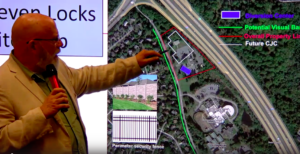 During a meeting Thursday, leaders explained details of a future diversion center in Rockville aimed to help decompress the criminal justice system as well as hospital emergency departments.
During a meeting Thursday, leaders explained details of a future diversion center in Rockville aimed to help decompress the criminal justice system as well as hospital emergency departments.
The center will be for adults undergoing a mental health or substance use crisis, who are transferred after release from the detention center, transported via police officer or ambulance, or transported from a hospital, Assistant Chief Administrative Officer Dr. Earl Stoddard said during the meeting.
It is open to residents transported directly for that purpose. 45 beds are planned and there will be no walk-ins.
Stoddard noted “45 beds is wholly insufficient to address the mental health crisis in Montgomery County, or substance use crisis for that matter.”
“Having it be open to walk-ins, frankly, we would not be able to ever have beds available for walk-ins,” he said.
The goal of the diversion is to have a site that intercepts the point of drop-off at the county’s Central Processing Unit (CPU), where arrests are booked. They would be evaluated at the facility.
The center is planned close to the CPU on Seven Locks Road in Rockville. The site allows “an intervention at the last possible moment” so officers don’t drive to one location for evaluation and then drive across the county for booking at CPU if mental health treatment is not appropriate.
“We want it to be right before that door where you’re going to go into the criminal justice system,” Stoddard said.
 During the meeting, a Seven Locks resident expressed objections to putting the facility in a residential area.
During the meeting, a Seven Locks resident expressed objections to putting the facility in a residential area.
He said residents made their feelings known multiple times.
“We feel it should be in an area where there’s a lot of healthcare facilities,” he said.
There will be security fencing around the facility, “but again we don’t want it to look intimidating or marshal in any way,” said Department of General Services Director David Dise, adding there are fences “that add to the aesthetics but also address security.”
The center will be about 11,000-12,000 square feet, Dise said, and a future Criminal Justice Center — to replace the detention center — will be about 70,000 square feet.
 The project is currently in the design phase.
The project is currently in the design phase.
Leaders expect 65-75% of the space will be used by people facing arrest but for whom mental health is the core need. They would be diverted to the center to prevent incarceration.
The rest of the space would help decompress hospitals, based on current estimations.

